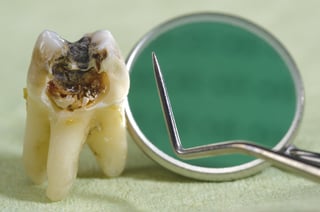Share this
Dental implants vs root canal treatment
on August 30, 2017

Dentists are taught to save teeth. Cavities in teeth are caused by bacteria eroding away the enamel and dentine. At this stage, the decayed portion of the tooth can be drilled away and the resultant defect filled with an inert material such as amalgam or increasingly, tooth colored composites. If the decay had progressed deeper into the pulp of the tooth, root canal treatment, aka endodontic treatment, whereby the pulpal tissue is removed from the root canals of the tooth and then sealing the empty canals with a filling, can often save the tooth from extraction. However, if the decay has progressed even further as to leave minimal sound tooth structure, extraction may be the only choice left. This is where dental implant come in as a replacement for the missing tooth. Where do we draw the line as to when it is better to remove and replace than to salvage the tooth?
Root Canal Treatment & Crown
As a general principle, it is better to preserve natural teeth than to replace with dental implants. Studies have shown that root canal treated teeth can last a long time. Although such a tooth does not have nerves and blood supply, it still has sensation as it is attached to the bone via periodontal ligaments. As such, the ability to sense the tooth is still present. Furthermore, the contour of the root and crown of a natural tooth is preserved and oral hygiene maintenance is more convenient. The oft-cited risk of endodontic treatment is that of fracture of the tooth due to the brittleness associated with non-vital teeth. In the event that the tooth does fracture, removal and replacement with a dental implant is still a viable option.
Dental Implant
A dental implant is a titanium screw that is inserted into the jaw bone to support a prosthetic crown. It is attached to the bone directly, with no intervening soft tissue like the periodontal ligament of a natural tooth. The bond between the bone and the implant is subjected to the effects of the biting forces as well as bacterial action, just like a natural tooth, though its response to such influences is different. Long term overloading and chronic bacterial infection of the implant can cause a breakdown in the bone attachment leading to loosening of the implant. If an implant fails, it is possible to replace with another implant but every often, some additional procedures such a bone grafting or gingival grafting may be required.
Medisave for dental implants….
In Singapore, there is an increasing trend favoring extraction and replacement with implant over preserving a tooth with root canal treatment. This may be due to dental financing model. Surgical extraction of a rotten tooth and replacement with a dental implant can be financed with a patient’s Medisave account. However, endodontic treatment and restoration with a crown need to be paid directly by the patient. Such a financing model has skewed patient’s choice towards extracting teeth that are otherwise salvageable as it involves less out of pocket expenses. Increasingly, teeth that can be saved are extracted and replaced with implants. Some dentists add to the problem by over simplifying the risk of dental implant surgery as well as the long term maintenance needed. While cost is always a concern, patients must understand the pros and cons of each option before making a decision.
When it is better to extract..
- Unrestorable tooth
While a very badly decayed can be saved by having root canal treatment, it may not be functional if the lost tooth structure cannot be rebuilt with a crown. The root canal treatment merely removes the infected pulp and decayed tooth structure, rendering the tooth free of infection. For the tooth to be functional, a crown is placed over the remaining tooth structure to restore the shape and hence the function of the tooth. If there is insufficient tooth structure left, a crown cannot be placed and the tooth will be non-functional. In such cases, it is better to remove the tooth and replace with an implant.
For a patient who have lost most of his teeth and left with just a few teeth, extraction of the remaining teeth to make way for a full arch prosthesis may be better than trying to save them and replace only the missing ones with implants. Keeping these teeth may result in needing more implants compared with a full arch prosthesis, depending on the load distribution. Aesthetics and function of the new prosthesis will also be compromised by retaining the few remaining teeth as the prosthesis has to conform to the existing dentition.
Crowded and overlapping teeth are difficult to maintain. When one of these crowded teeth are lost, replacement with dental implant is challenging. If the remaining teeth are also rotten, extraction and replacement with dental implant supported prosthesis will enable a proper alignment thereby facilitating oral hygiene maintenance as well as improving the aesthetics.
There are always different options to solve a problem. The decision making process is one of balancing the risks and benefits of each option in the context of the specific patient. The same condition in a different patient may present with a different risk-benefit ratio and hence a different option. Root canal treated teeth restored with a well-made crown has similar prognosis to an implant-supported crown. Decision to opt for one treatment over another needs to take into consideration other local and systemic factors specific to the patient.
Share this
- Jaw Surgery (93)
- Dental Implants Singapore (90)
- Orthognathic Surgery (48)
- Replacing Missing Teeth (26)
- Missing Teeth Options (23)
- Underbite (23)
- Bone Grafting (21)
- Costs (18)
- Facial Aesthetics (18)
- Aesthetics (17)
- dental implants (16)
- corrective jaw surgery (15)
- BOTOX (11)
- Dermal Fillers (11)
- Wisdom teeth (10)
- Fixed Implant Dentures (8)
- Loose Dentures Singapore (6)
- Medisave (6)
- sleep apnea (6)
- Braces (5)
- Dental Pain (5)
- Dentures in Singapore (5)
- Loose Teeth (5)
- Tooth Extraction (5)
- jaw deformities (5)
- bimax (4)
- bone graft (4)
- maxillomandibular advancement (4)
- all-on-4 (3)
- bimaxillary protrusion (3)
- chin implant (3)
- facial asymmetry (3)
- full mouth dental implants (3)
- genioplasty (3)
- immediate implant (3)
- removal of an integrated dental implant (3)
- third molars (3)
- wisdom tooth surgery (3)
- My Dentures Don't Fit (2)
- VME (2)
- bone graft healing (2)
- distraction osteogenesis (2)
- medical tourism (2)
- obstructive sleep apnea (2)
- orthodontics (2)
- plastic surgery (2)
- CT guided dental implants (1)
- Double jaw surgery (1)
- Invisalign (1)
- Periodontal Disease (1)
- Permanent Dentures Singapore (1)
- before and after photos (1)
- facial trauma (1)
- fractured dental implant (1)
- oral appliance therapy (1)
- root canal treatment (1)
- veneers (1)
- vertical maxillary excess (1)
- September 2019 (2)
- July 2019 (2)
- May 2019 (2)
- August 2018 (1)
- October 2017 (1)
- September 2017 (2)
- August 2017 (1)
- June 2017 (2)
- May 2017 (4)
- April 2017 (1)
- March 2017 (1)
- February 2017 (3)
- January 2017 (3)
- December 2016 (1)
- November 2016 (2)
- October 2016 (4)
- September 2016 (9)
- August 2016 (5)
- July 2016 (11)
- June 2016 (14)
- May 2016 (6)
- April 2016 (2)
- March 2016 (1)
- January 2016 (7)
- December 2015 (10)
- November 2015 (4)
- October 2015 (9)
- September 2015 (7)
- August 2015 (1)
- July 2015 (6)
- June 2015 (3)
- May 2015 (7)
- April 2015 (5)
- March 2015 (8)
- January 2015 (5)
- December 2014 (7)
- November 2014 (7)
- October 2014 (6)
- September 2014 (8)
- August 2014 (5)
- July 2014 (7)
- June 2014 (8)
- May 2014 (9)
- April 2014 (10)
- March 2014 (6)
- February 2014 (8)
- January 2014 (3)
Subscribe by email
Email subscription




No Comments Yet
Let us know what you think